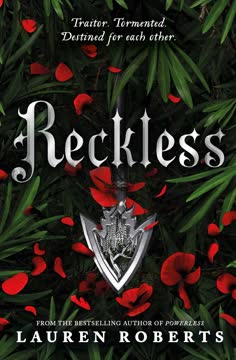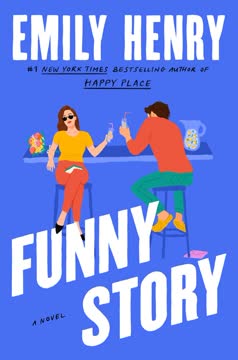Plot Summary
Running From Shadows
Daisy tries to escape her past. Daisy Haites is determined to leave behind her criminal family, her dangerous brother Julian, and her complicated love for Christian Hemmes. She attempts to build a new, "normal" life with Tiller, a kind-hearted American policeman, but the shadows of her past are never far. When her apartment is broken into and mysterious roses begin appearing at her door, Daisy's fragile sense of safety shatters. Despite her efforts to be ordinary, Daisy is forced to confront the reality that her old life—and the people in it—are not done with her.
Unfinished Business
Old loves and loyalties resurface. Christian, Daisy's ex, is haunted by his love for her and the choices that drove them apart. He's entangled in the criminal world with Julian, Daisy's brother, and can't let go of the past. Meanwhile, Julian, on the run from the law, is both Daisy's protector and her greatest source of pain. The trio's unresolved feelings and shared history create a web of tension, as each struggles with loyalty, regret, and the desire for redemption.
The Watchful Brother
Julian's protection comes at a cost. Julian's love for Daisy is fierce and possessive, manifesting as both protection and control. He keeps tabs on her through his network, even as he's forced into exile. When Daisy's safety is threatened, Julian's criminal instincts kick in, pulling her back into the world she tried to escape. His inability to let go of his sister, and his own emotional wounds, set the stage for a collision between family loyalty and personal freedom.
Roses and Daisies
A stalker's gifts escalate the danger. The mysterious delivery of roses, and later daisies, signals a growing threat to Daisy's life. The flowers, once symbols of affection, become ominous warnings. Tiller, Christian, and Julian all scramble to identify the sender, but the danger only draws Daisy deeper into the orbit of her old life. The stalker's presence is a catalyst, forcing old alliances to reform and secrets to surface.
The Return to Crime
Daisy is pulled back in. As the threats intensify, Daisy is forced to seek protection from Julian and his criminal associates. The safety of the Compound—a fortress-like home for Julian's crew—becomes both a sanctuary and a prison. Daisy's attempts at normalcy crumble as she's drawn into the family's criminal operations, using her medical skills to save lives and navigate the moral gray areas of her upbringing.
Love's Old Ghosts
Romantic entanglements complicate everything. Daisy's heart is torn between Tiller, who offers her stability and hope for a normal life, and Christian, whose love is passionate but dangerous. Their triangle is mirrored by Julian's unexpected feelings for Magnolia Parks, a glamorous socialite with her own baggage. As new relationships form and old ones are tested, love becomes both a refuge and a weapon.
The Threat Arrives
Violence shatters the illusion of safety. The stalker's threats escalate to violence, culminating in a deadly attack in a parking garage. Daisy narrowly escapes, but her friend Grace is killed. The attack forces Daisy to return to the Compound, where Julian's control tightens and the lines between family, love, and survival blur. The trauma of the attack reverberates through the group, exposing vulnerabilities and deepening old wounds.
Family Ties Fray
Secrets and betrayals come to light. The pressure of constant danger strains every relationship. Daisy's loyalty to her brother is tested as she uncovers secrets about his criminal dealings. Julian's own past comes back to haunt him, and his relationship with Magnolia is threatened by the ghosts of her own history. The family's code—never betray your own—becomes harder to uphold as the stakes rise.
The Great Betrayal
Trust is shattered by lies and omissions. Daisy's relationship with Tiller unravels as he struggles to reconcile his love for her with her criminal ties. When a sex tape of Christian and his ex, Vanna, is leaked, Daisy is devastated. The scandal exposes the fragility of trust and the destructive power of secrets. As Daisy and Christian confront their past mistakes, they must decide whether love can survive betrayal.
The Compound's Embrace
Daisy is forced to choose sides. With danger closing in, Daisy must choose between the safety of the Compound and the possibility of a life outside crime. Her medical skills make her indispensable, but her heart longs for freedom. The Compound becomes a crucible, testing the bonds of family, friendship, and love. Daisy's choices will determine not only her own fate, but the future of everyone she cares about.
Sinking Ships
Love is not enough. Daisy and Tiller's relationship, once a lifeline, becomes a sinking ship. Their inability to bridge the gap between their worlds leads to heartbreak. Meanwhile, Julian and Magnolia's romance is undone by the violence and danger that surround them. The realization that love cannot conquer all is a painful but necessary lesson for everyone involved.
The Art of Survival
Crime, loyalty, and sacrifice. The search for a missing painting, criminal deals, and the constant threat of violence force the characters to confront the realities of their world. Daisy's medical expertise saves lives, but also implicates her in the family's crimes. Julian's leadership is tested as he tries to protect his sister and his crew. Survival requires sacrifice, and not everyone will make it out unscathed.
The Magnolia Effect
Magnolia's presence changes everything. Magnolia Parks, with her beauty and brokenness, becomes a catalyst for change. Her relationship with Julian is passionate but doomed, haunted by the memory of a lost child and the shadow of BJ, her first love. Magnolia's friendship with Daisy offers both women a chance at healing, but also exposes them to new dangers.
Collateral Damage
Violence and loss ripple outward. The attacks on the family escalate, with Santino Bambrilla and Rebecca Barnes (Christian's mother) both targeted. The violence leaves physical and emotional scars, forcing everyone to confront the cost of their choices. The family's enemies are relentless, and the price of survival is higher than anyone anticipated.
The Sex Tape Scandal
Public humiliation and private pain. The leak of Christian's sex tape with Vanna threatens to destroy his relationship with Daisy. The scandal is a test of trust, forgiveness, and resilience. With the help of Magnolia's cunning, the truth behind the leak is exposed, but the damage is done. Daisy and Christian must decide whether their love can withstand the scrutiny and betrayal.
The Last Goodbye
Letting go to save each other. Julian, realizing that his love for Magnolia puts her in danger, orchestrates a painful breakup. Daisy and Christian, after surviving betrayal and violence, plan to leave London together and start anew. The family's enemies close in, forcing desperate measures and heartbreaking choices.
The Great Undoing
Everything falls apart. A coordinated attack leaves Magnolia gravely injured and Daisy kidnapped for her own safety. The family is scattered, love is lost, and the future is uncertain. The characters are forced to confront the reality that their lives can never be truly free from the past.
Flight Into Darkness
Escape, exile, and uncertain hope. Daisy is smuggled out of the country by Julian and Romeo, leaving Christian behind. The novel ends with everyone undone—by love, by violence, by the impossibility of escaping who they are. The great undoing is both a tragedy and a new beginning, as the survivors are forced to reckon with the cost of survival and the hope of redemption.
Characters
Daisy Haites
Haunted, resilient, torn between worlds. Daisy is the emotional core of the novel—a young woman desperate for normalcy but bound by blood to a criminal dynasty. Her intelligence, medical skill, and fierce loyalty make her both a healer and a fighter. Daisy's relationships with her brother Julian and her lovers, Tiller and Christian, are fraught with longing, betrayal, and impossible choices. She is defined by her capacity to love deeply, her fear of abandonment, and her struggle to reconcile her past with her hopes for the future. Daisy's journey is one of self-discovery, as she learns that survival sometimes means letting go.
Julian Haites
Charismatic, dangerous, broken protector. Julian is both Daisy's savior and her jailer—a gang lord whose love for his sister is as possessive as it is protective. He is haunted by guilt, trauma, and the violence of his world. Julian's leadership is marked by ruthlessness, but his vulnerability is exposed in his love for Daisy and his doomed romance with Magnolia. He is a study in contradictions: charming yet brutal, loyal yet manipulative, desperate for connection yet unable to let go. Julian's arc is one of tragic self-sacrifice, as he gives up love to keep those he cares about safe.
Christian Hemmes
Passionate, loyal, self-destructive lover. Christian is Daisy's great love—a man torn between the criminal world and the hope of redemption. His relationship with Daisy is intense, marked by longing, jealousy, and forgiveness. Christian's own wounds—family trauma, guilt, and a history of violence—mirror Daisy's. He is both her salvation and her undoing. Christian's journey is one of learning to let go of pride, to fight for love, and to accept that happiness may require leaving everything behind.
Tiller
Steady, good-hearted, out of his depth. Tiller represents the possibility of a normal life for Daisy. As a policeman, he is everything her family is not: honest, dependable, and kind. But his inability to accept Daisy's past, and the danger that comes with it, ultimately dooms their relationship. Tiller's struggle is one of loving someone he cannot save, and learning that sometimes love is not enough.
Magnolia Parks
Beautiful, broken, catalyst for change. Magnolia is a socialite whose presence disrupts the lives of everyone around her. Her complicated history with BJ, her friendship with Daisy, and her romance with Julian make her both a source of healing and chaos. Magnolia is haunted by loss, driven by a need for love, and capable of both great kindness and self-destruction. She is a mirror for Daisy, showing what it means to survive heartbreak and keep going.
Romeo Bambrilla
Protector, loyal friend, tragic hero. Romeo is Daisy's childhood friend and former lover, always ready to step in when she is in danger. His loyalty is unwavering, but his own wounds and unrequited love for Daisy make him a tragic figure. Romeo's role as protector is both a blessing and a curse, as he is forced to choose between his own happiness and Daisy's safety.
Miguel
Bodyguard, silent guardian, moral compass. Miguel is Julian's trusted enforcer and Daisy's reluctant protector. He is a stabilizing force, often providing practical wisdom and emotional support. Miguel's loyalty to the Haites family is tested by the escalating violence, but his commitment to Daisy's safety never wavers.
BJ Ballentine
Wounded, possessive, unable to let go. BJ is Magnolia's first love and the source of much of the novel's emotional turmoil. His inability to move on, his jealousy, and his own trauma make him both a victim and a perpetrator of heartbreak. BJ's relationship with Magnolia is a cautionary tale about the dangers of loving someone too much.
Jack
Comic relief, loyal friend, emotional anchor. Jack is Daisy's best friend, providing humor, support, and a sense of normalcy amid the chaos. His own romantic struggles mirror the larger themes of the novel, and his friendship with Daisy is a reminder of the importance of chosen family.
Grace Pal
Innocent casualty, symbol of lost innocence. Grace is a colleague of Daisy's whose death in a targeted attack is a turning point in the novel. Her loss is a stark reminder of the collateral damage caused by the family's criminal life, and her memory haunts Daisy as she grapples with guilt and grief.
Plot Devices
Dual Narratives and Shifting Perspectives
Multiple voices reveal emotional complexity. The novel alternates between Daisy, Christian, Julian, and other key characters, providing a kaleidoscopic view of events. This structure allows for deep psychological insight, as each character's motivations, fears, and desires are laid bare. The shifting perspectives create dramatic irony, as the reader knows more than any one character, heightening tension and empathy.
Symbolic Motifs: Flowers and Art
Flowers and stolen art as emotional barometers. Roses and daisies are recurring symbols, representing both love and threat. The delivery of flowers marks key turning points, signaling danger or longing. Stolen art and priceless objects serve as metaphors for the characters' attempts to possess, protect, and ultimately lose what they value most. These motifs underscore the novel's themes of beauty, loss, and the impossibility of holding on to what matters.
The Compound and the Safe Room
Physical spaces as psychological prisons. The Compound, Julian's fortress, is both a sanctuary and a cage. The safe room, filled with weapons and memories, represents Daisy's inability to escape her past. These settings are used to explore the tension between safety and freedom, and the ways in which love can both protect and imprison.
Foreshadowing and Repetition
Hints of doom and cycles of trauma. The novel is rich in foreshadowing, with repeated references to sinking ships, lost children, and the inevitability of loss. The characters' repeated mistakes—choosing the wrong lover, betraying trust, running from danger—create a sense of tragic inevitability. The use of repetition reinforces the idea that the past cannot be escaped, only survived.
The Sex Tape Scandal
Public exposure as a test of love. The leak of Christian's sex tape is a plot device that forces Daisy and Christian to confront their insecurities, jealousy, and the limits of forgiveness. The scandal is both a literal and metaphorical exposure, laying bare the characters' vulnerabilities and the destructive power of secrets.
The Final Flight
Escape as both ending and beginning. The novel's climax—a desperate flight from London to escape assassination—serves as both a literal and symbolic undoing. The characters are forced to leave behind everything they know, sacrificing love, safety, and identity for the hope of survival. The open-ended conclusion leaves the future uncertain, but suggests that undoing may be the first step toward healing.
Analysis
A meditation on love, trauma, and the impossibility of escape. Daisy Haites: The Great Undoing is a raw, emotionally charged exploration of what it means to love and survive in a world defined by violence, betrayal, and loss. Jessa Hastings uses the conventions of crime fiction and romance to probe deeper questions about family, identity, and the cost of survival. The novel's shifting perspectives and rich symbolism create a tapestry of longing, regret, and hope. At its core, the book is about the ways in which love can both save and destroy us—the impossibility of leaving the past behind, and the courage required to keep going anyway. The lesson is clear: survival is not about escaping pain, but about finding meaning in the undoing, and choosing, again and again, to love in the face of inevitable loss.
Last updated:
FAQ
Synopsis & Basic Details
What is Daisy Haites: The Great Undoing about?
- Attempting a Normal Life: Daisy, sister to notorious gang lord Julian, tries to build a life free from crime, her family, and her complicated ex, Christian, finding solace with policeman Tiller.
- Past Life Intrusion: Her efforts are thwarted when threats emerge, forcing her back into the dangerous orbit of her brother and Christian, who are determined to protect her.
- Entangled Relationships & Danger: As Daisy navigates her rekindled connection with Christian and Julian unexpectedly falls for socialite Magnolia, their intertwined lives face escalating threats from Julian's past, leading to devastating consequences.
Why should I read Daisy Haites: The Great Undoing?
- Deep Emotional Complexity: The novel delves into the raw, often contradictory emotions of characters trapped between loyalty, love, and a life of crime, offering a compelling psychological exploration.
- Intricate Relationship Dynamics: It presents complex, messy relationships—from Daisy's love triangle to Julian's unexpected romance and the deep bonds within their crews—that feel intensely real and drive the narrative.
- Suspenseful Blend of Genres: Combining elements of romance, crime thriller, and psychological drama, the story keeps readers engaged with escalating danger, moral ambiguity, and high-stakes emotional conflict.
What is the background of Daisy Haites: The Great Undoing?
- London's Criminal Underworld: The story is set within a fictionalized version of London's organized crime families, known as the Boroughs, hinting at a long-standing, inherited system of power and illicit activities.
- Contrast with 'Normal' Society: It sharply contrasts the opulent, yet violent, world of the crime families with attempts at conventional life, highlighting the difficulty of escaping one's origins and the societal divide.
- Sequel Context: The novel builds upon events and relationships established in previous books in the series, particularly the tumultuous history between Daisy, Julian, and Christian, and Julian's previous exile.
What are the most memorable quotes in Daisy Haites: The Great Undoing?
- "There's no such thing [as just sex].": Tiller's simple yet profound statement to Daisy after their first intimate encounter (Chapter 1) foreshadows his deeper emotional investment and contrasts with Daisy's initial attempt to compartmentalize their relationship, highlighting themes of connection and vulnerability in Daisy Haites.
- "You're the sun, Face! You're the sun that shines on everything and makes it all light and you're the thing makes us know right from wrong — and when you left we got worse, but now you're back.": Julian's raw admission to Daisy (Chapter 16) reveals the depth of his dependence on her moral compass and the impact of her absence on him and his crew, underscoring the central theme of Daisy's influence on the criminal world.
- "I am fucked up in love with you. Have never stopped loving you, since the second I realised I did, and I admit it, it took me too long to know it but I know it now, and I can't unknow it.": Christian's passionate confession to Daisy (Chapter 41) encapsulates his enduring love and regret, marking a pivotal emotional turning point and directly addressing his past mistakes in their relationship analysis.
What writing style, narrative choices, and literary techniques does Jessa Hastings use?
- Dual Narratives and Shifting Perspectives: The narrative frequently shifts between the first-person perspectives of Daisy, Christian, and Julian, offering immediate access to their internal thoughts, motivations, and emotional states, enriching character analysis.
- Colloquial and Informal Tone: The writing employs a conversational, often stream-of-consciousness style, particularly in internal monologues, reflecting the characters' youth and raw emotionality, making their voices distinct and relatable.
- Heavy Use of Subtext and Dialogue: Meaning is often conveyed through unspoken thoughts, subtle reactions, and the space between dialogue, requiring readers to actively interpret character connections and underlying tensions.
Hidden Details & Subtle Connections
What are some minor details that add significant meaning?
- Julian's Dog, LJ: Named "Little Julian," the fiercely protective guard dog immediately takes to Daisy (Chapter 5), symbolizing Julian's deep, instinctual protectiveness of his sister despite their estrangement and highlighting the complex Julian Haites motivation rooted in family loyalty.
- Daisy's Hidden Medical Room: The secret, fully-equipped surgical room in Daisy's apartment (Chapter 6) reveals that despite her pursuit of normalcy, she never fully abandoned the skills and preparedness necessary for her old life, foreshadowing her inevitable return to using them and complicating her desire for a normal life analysis.
- The Gardener in Italy: The seemingly minor character from Daisy's childhood memory (Chapter 43) who made her uncomfortable and led her to hide, foreshadows the theme of vulnerability and the need for escape that resurfaces throughout her life, connecting past trauma to present anxieties.
What are some subtle foreshadowing and callbacks?
- The Sinking Ship Metaphor: Daisy's recurring thought of her life, and later her relationship with Tiller, as a "sinking ship" (Chapter 13, 19, 29, 32) subtly foreshadows inevitable loss and the difficulty of escaping a predetermined fate, linking her personal relationships to broader themes of doom in Daisy Haites.
- Julian's Jack Dawson Speech: Julian's quoting of the Titanic monologue (Chapter 17) about living life without knowing what's next, initially presented as charming deflection, subtly foreshadows his own reckless approach to life and love, which ultimately leads to his "sinking" and the loss of Magnolia.
- Christian's Car as a Symbol: Daisy's nostalgic attachment to Christian's car (Chapter 36) where they had significant moments, including their reunion sex, serves as a callback to their shared history and symbolizes the enduring connection and comfort she finds in him, linking physical spaces to emotional history.
What are some unexpected character connections?
- Daisy and Magnolia's Friendship: Despite their initial connection through Julian and Christian, Daisy and Magnolia develop a genuine, albeit peculiar, friendship (Chapter 24, 26, 42, 50, 58), offering mutual support and understanding rooted in their shared experiences with the Hemmes/Haites men and their own traumas, adding a layer to the Magnolia Parks analysis.
- Julian and Tiller's Mutual Respect: Despite being on opposite sides of the law and rivals for Daisy's affection, Julian and Tiller develop a grudging respect, even finding common ground (Chapter 17, 26), highlighting the complexity of character motivations beyond simple antagonism and showing Julian Haites's capacity for connection.
- Christian and Julian's Alliance: Christian actively helps Julian, including finding the Van Gogh painting (Chapter 2), demonstrating a loyalty that transcends their rivalry for Daisy and their differing roles in the criminal world, revealing a deeper bond forged through shared history and mutual understanding of Daisy's importance.
Who are the most significant supporting characters?
- Romeo Bambrilla: More than just an ex, Romeo is Daisy's unwavering protector and confidante (Chapter 11, 15, 36, 55, 60, 69), representing her past and the deep, complicated loyalty within the Boroughs, his actions often directly impacting her safety and emotional state.
- Magnolia Parks: While seemingly a romantic interest for Julian, Magnolia becomes a significant force through her unexpected friendship with Daisy and her disruptive influence on the group dynamics (Chapter 24, 26, 42, 50, 58, 59), acting as a catalyst for emotional revelations and plot developments, crucial for Magnolia Parks analysis.
- Miguel: Daisy's assigned bodyguard, Miguel (Chapter 1, 5, 12, 29, 34, 61, 69) serves as a constant reminder of her inability to fully escape her past, while also providing moments of dry humor and steadfast protection, embodying the ever-present danger and the complex nature of loyalty in Daisy Haites.
Psychological, Emotional, & Relational Analysis
What are some unspoken motivations of the characters?
- Daisy's Pursuit of Normalcy: Beyond stated desires, Daisy's intense drive for a "normal" life (Chapter 1, 6, 13) is deeply rooted in her childhood trauma and fear of abandonment, a subconscious attempt to create the stable, predictable life she never had after her parents' death and the chaos of her upbringing.
- Julian's Need for Control: Julian's possessiveness over Daisy and his crew (Chapter 3, 5, 12) stems from a deep-seated fear of losing the few people he allows himself to care about, a coping mechanism developed after the loss of his parents and the inherent instability of his world, revealing core Julian Haites motivation.
- Christian's Self-Sabotage: Christian's initial reluctance to fully commit to Daisy and his later self-destructive behavior (Chapter 2, 9, 20, 30) are driven by a subconscious belief that he is not worthy of happiness or a normal life, a result of his family's history and his entanglement in crime, impacting his Christian Hemmes motivation and relationships analysis.
What psychological complexities do the characters exhibit?
- Trauma Responses: Daisy exhibits complex trauma responses, including a need for control (the safe room), difficulty with intimacy (using sex as a coping mechanism), and a deep fear of abandonment, all stemming from her violent upbringing and parental loss (Chapter 1, 6, 13, 29, 43).
- Inherited Patterns: Characters like Julian, Christian, and Daisy repeat destructive patterns established by their parents and the Boroughs system (Chapter 3, 6, 43, 45, 62), highlighting themes of nature vs. nurture and the difficulty of breaking cycles of violence and emotional unavailability.
- Emotional Repression and Deflection: Julian frequently uses humor, aggression, and deflection (the Jack Dawson speech, Chapter 17; his reaction to Magnolia's crying, Chapter 23) to avoid confronting his deeper emotions, particularly love and vulnerability, showcasing a complex coping mechanism in Julian Haites analysis.
What are the major emotional turning points?
- The Hospital Confrontation: Daisy and Julian's explosive fight in the hospital (Chapter 3) marks a severe rupture in their relationship, driven by Julian's harsh words and Daisy's perceived betrayal, leading to their estrangement and setting the stage for much of the subsequent emotional conflict.
- The Car Park Attack: The violent attack and Grace's death (Chapter 11) shatters Daisy's illusion of safety in her normal life, forcing her to confront the inescapable danger tied to her identity and triggering a return to the Compound and reliance on her old skills.
- The Sex Tape Scandal: The public exposure of Christian's sex tape (Chapter 55) is a major emotional blow for Daisy, forcing her to confront jealousy, trust issues, and the public scrutiny tied to Christian's life, leading to a temporary break and deeper introspection about their relationship analysis.
How do relationship dynamics evolve?
- Daisy and Tiller: Their relationship shifts from a hopeful escape to a strained compromise (Chapter 1, 13, 19), ultimately dissolving under the weight of their incompatible worlds and Tiller's inability to fully accept Daisy's past (Chapter 29, 32, 34), illustrating the theme that love isn't always enough.
- Julian and Magnolia: What begins as a casual, almost antagonistic attraction (Chapter 10, 23) deepens into genuine affection and love (Chapter 25, 28, 31, 33, 38, 40, 44, 46, 49, 51), only to be tragically sacrificed by Julian to protect her from the dangers of his life (Chapter 51, 54), highlighting the high cost of love in their world.
- Daisy and Christian: Their dynamic is a constant push-and-pull between deep love and the obstacles of their lives (Chapter 2, 6, 9, 18, 20, 27, 30, 35, 37, 41, 48, 57, 59), marked by past hurt, lingering feelings, and moments of intense connection, ultimately leading to a renewed attempt at a relationship despite the chaos (Chapter 59, 65).
Interpretation & Debate
Which parts of the story remain ambiguous or open-ended?
- The Stalker's True Identity/Motivation: While Ezra Brown is implicated in the later attacks (Chapter 51), the initial sender of the roses and daisies is never definitively confirmed, leaving a lingering question about whether the early threats were connected to the later, more violent ones or had a different source.
- The Future of Daisy and Christian's Relationship: Despite their renewed commitment and plan to leave London (Chapter 65), the final flight separates them (Chapter 69), leaving their future together uncertain and open to interpretation regarding whether their love can survive the forced separation and ongoing danger.
- Magnolia's Fate: After the car crash (Chapter 66), Magnolia's condition is left ambiguous ("Still in surgery," "I don't know" if she's okay, Chapter 68), allowing readers to debate whether she survives and what her future might hold, particularly regarding her relationship with BJ and Julian.
What are some debatable, controversial scenes or moments in Daisy Haites: The Great Undoing?
- Daisy's Actions in the Car Park Attack: Daisy's immediate focus on trying to save Grace despite Romeo's insistence she's dead (Chapter 11) can be debated as either heroic medical instinct or a potentially reckless response in a highly dangerous situation, highlighting her internal conflict between her medical training and the realities of her life.
- Julian's Decision to End Things with Magnolia: Julian's abrupt and seemingly cruel breakup with Magnolia (Chapter 38, 51, 54), motivated by a desire to protect her, is debatable in its execution, raising questions about whether his method was necessary or caused unnecessary pain, and if there could have been another way to ensure her safety.
- Christian's Reaction to the Sex Tape Scandal: Christian's initial casual reaction to Daisy's distress over his sex tape (Chapter 55) is controversial, sparking debate about his emotional intelligence and whether his perspective (it was just sex, it was old) is valid or dismissive of Daisy's feelings of betrayal and public humiliation.
Daisy Haites: The Great Undoing Ending Explained: How It Ends & What It Means
- The Great Undoing: The novel culminates in a series of devastating events: an attack targeting Magnolia leaves her critically injured, and Daisy is forcibly taken by Romeo and Miguel for her safety (Chapter 66, 69). This "great undoing" shatters the characters' lives and relationships, particularly separating Daisy from Christian and Julian from Magnolia.
- Forced Exile: Daisy is flown out of the country by Julian and Romeo (Chapter 69), against her will, to protect her from the escalating threats linked to Julian's enemies. This mirrors Julian's earlier exile and signifies that escaping the consequences of their world is impossible, even for those who desire a normal life.
- Uncertain Futures: The ending leaves the fates of several characters ambiguous (Magnolia's survival, Daisy and Christian's reunion, Julian's emotional state) and underscores the novel's central themes: the inescapable nature of their past, the high cost of love and loyalty in a violent world, and the idea that survival often comes at the price of profound loss and separation.
Review Summary
Daisy Haites receives mixed reviews, with some readers loving the emotional depth and character development, particularly for Daisy and Christian. However, many criticize the excessive focus on Julian and Magnolia, feeling it overshadowed the main characters. The book's plot is described as lacking, with most events revolving around relationships and drama. Readers express frustration with the ending and the author's perceived bias against Daisy. Despite these criticisms, many still find the romance between Daisy and Christian compelling and eagerly anticipate the next installment.
Magnolia Parks Universe Series
Similar Books
Download PDF
Download EPUB
.epub digital book format is ideal for reading ebooks on phones, tablets, and e-readers.


















